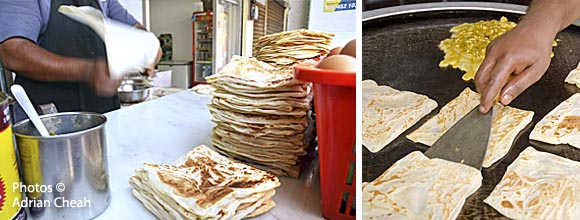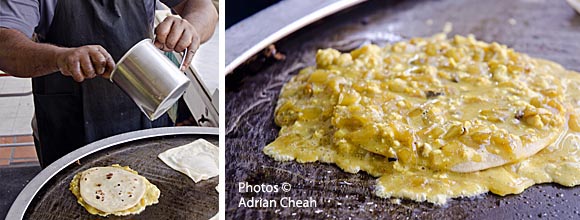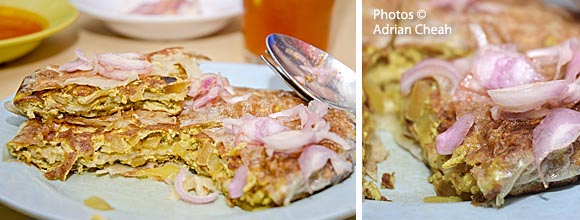The murtabak – a hearty meal all by itself

Hameediyah Restaurant in Campbell Street serves good murtabak. Established in 1907, this is one of the oldest Indian Muslim restaurants in Penang.

Although of Chinese descent, my late father could converse fluently in Urdu and Hindi and was a good friend of the owners, Abu Bakar and Abdul Sukkoor, as well as the staff of Hameediyah. Through the years, food was invariably the catalyst of their meetings. My love for curries must have grown from there. As a young boy, I was always fascinated with the culinary showmanship of the roti canai maker, twirling each ball of dough in mid-air to stretch it into a very thin sheet. I would also observe how from this dough, one of my favourite meals – the murtabak – is prepared.


The key components of the murtabak are a mixture of beaten eggs and a pre-cooked filling of minced meat, diced onions and spices. After whisking these components thoroughly in a metal cup with a fork, half of the mixture is poured into the frying pan; this is topped with a square roti canai sheet, on top of which the rest of the mixture is poured. Ghee is then sprinkled liberally.
When both sides are cooked, the omelet-like filling is removed from the hot plate and placed in the centre of a large thinly stretched pastry. The pastry then wrapped the filling like an envelope and returned to the hot plate. It is fried till golden brown on both sides. Straight from the hot plate, this paper-thin outer skin is crispy, encasing the delicious filling within. The murtabak is commonly served with pickled onions and/or your choice of curry.

In Malaysia and Singapore, this unique dish is believed to have been created by the Indian Muslims (mamak) from South India who migrated to the shores of the Malay archipelago in the late 19th century. You would most probably not find this dish in India. Some believe that the dish could have an Arabian origin since the name Murtabak, written in Arabic as "mutabbaq", means folded.
Hameediyah offers a variety of the murtabak – chicken, mutton, beef, prawns and vegetarian. Throughout Penang, you can also sample this savoury dish at most hawker centres, pasar malams (night markets) and nasi kandar shops (e.g., Kapitan and Kassim Mustafa in Chulia Street) as it is quite popular among locals and tourists.
---------------------------------------------------------
Hameediyah Restaurant
164A Campbell Street, Penang | T: +604 2611095

The founder of Hameediyah Restaurant, Mr Mohamed arrived in Penang, then "Prince of Wales Island" in 1890, seeking better opportunities and a brighter future. Little did he realise that through his determination and perseverance, he would leave behind a lasting legacy that spans more than a century long. Although he was not trained as a cook, he pursued his dream and through the years, perfected his curries and dishes.
His humble beginnings as a nasi kandar peddler changed in 1907 when he started his restaurant business at 164A Campbell Street. Mohamed passed away in 1927 and his son Kader took over the helm; eventually, his three sons joined in the business. After World War II, Abu Bakar, a grandson of Kader took over the business and later, passed it on to a relative, Abdul Sukkor. Today, two of Abdul Sukkor's sons, Seeni Pakir and Syed Ibrahim run the restaurant, still serving authentic recipes that have been handed down through generations.
---------------------------------------------------------
Written and photographed by Adrian Cheah
© All rights reserved
Updated 27 October 2021